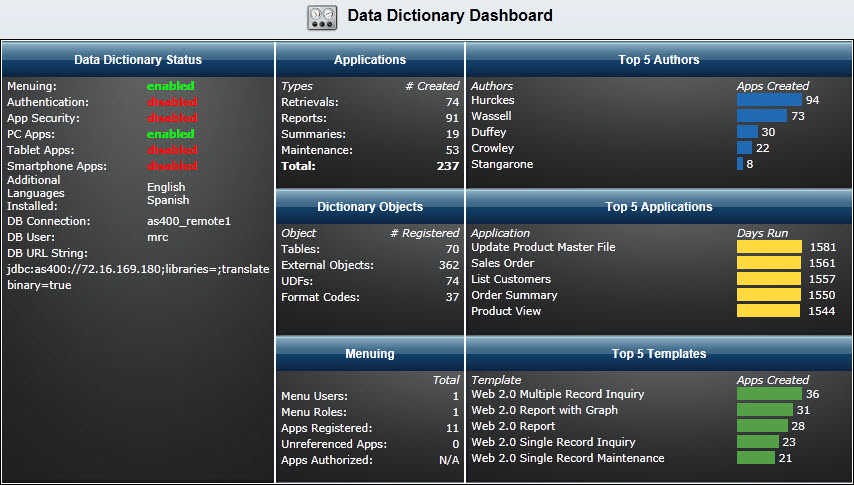Data Dictionary Reporting
Data Dictionary Reports allow m-Power developers to better understand the organization and hierarchy of their Data Dictionary. Developers can utilize Data Dictionary Reports in a number of ways, including:
- Viewing the Dictionary Dashboard, which provides numerous key statistics.
- Searching for where tables, fields, external objects, and UDFs are utilized with the Data Dictionary.
- Accessing a listing of all applications that utilize a certain template.
- A complete synopsis of application specification details.
- The ability to review Stored Procedure syntax auto generated by m-Power for External Objects.
Data Dictionary Dashboard
Below is a screen shot of the Data Dictionary Dashboard:
(Accessible via the Admin » Data Dictionary Reports » Data Dictionary Dashboard Option)

Notice that in the "Data Dictionary Status" column, the developer can get a snapshot of the features that are enabled within this m-Power Data Dictionary:
- Features that have not yet been activated are marked with a red "disabled."
- The Authentication option refers to Sign on Security.
- The App Security option refers to Application Level Security.
- The Dictionary's Database connectivity information is also displayed within this column. The DB User, and DB URL string utilized are provided.
- This useful information allows developers to better understand how applications in this dictionary are connecting to the database.
The second column listed provides a count of various Dictionary objects:
- The Applications area lists your application count, broken down by application type.
- The Dictionary Objects section lists the number of tables, objects, UDFs, and Format codes available to a developer of this Data Dictionary.
- The Menuing area allows developers to see a snapshot of how many users, roles, and applications are utilized in this Data Dictionary.
- Any applications that are listed on the menuing system but are not assigned to a given role will be noted under the Unreferenced Apps option.
- Lastly, the Apps Authorized option will display how many applications are accessible when Application Level Security is activated. If this feature has been disabled, "N/A" will be listed instead.
The third column lists popular Dictionary objects, for instance:
- The Top 5 Authors area lists the most active developers by the number of applications created.
- The Top 5 Applications section lists the most popular applications, by the number of days the application has been run.
- The Top 5 Templates area provides a breakdown of the number of applications created, by template type.
Standard Data Dictionary Reports

Aside from the Data Dictionary Dashboard, numerous other Data Dictionary Reports exist. Each of the following options provides a .pdf file that can be easily printed or sent to mrc Technical support, if necessary. These reports include:
- Field Synonyms — Provides a listing of all synonyms utilized in the Data Dictionary, including the affected tables.
- Table Layout — Lists all fields within a given table, including format codes and field descriptions.
- Table Where-Used — Scans all applications within the current Data Dictionary to determine where a given table has been used.
- Field Where-Used — Scans all applications within the current Data Dictionary to determine where a given field has been used.
- Object Where-Used — Scans all applications within the current Data Dictionary to determine where a given External Object has been used.
- UDF Where-Used — Scans all applications within the current Data Dictionary to determine where a given UDF has been used.
- Template Where-Used — Scans all applications within a given application type for the current Data Dictionary to determine where a given Template has been used.
- Retrievals, Report, Summary, or Maintenance Summary — Provides a print out of all applications of the selected type that have been created in the current Data Dictionary.
- Retrieval, Report, Summary, or Maintenance Details — Provides a detailed print out of all specifications for a given application. All specifications determined by the developer will be included in this Data Dictionary Report.
Other Data Dictionary Features
Outside of the "Data Dictionary Reports" section, other Data Dictionary Reports are available to help m-Power developers better understand their Data Dictionary, including:
- In-line "Where-Used" reports — Rather than having to always come back to the "Data Dictionary Reports" screen, developers can access "Where-Used" reports throughout the interface. For instance, within the "Admin — > Manage Tables" screen, developers can click on the In-line "Where-Used" icon to determine where a specific file has been used. This feature also exists in the:
- "Manage Fields" screen
- "Manage External Objects" screen
- "Manage User Defined Functions" screen
- "Manage Templates" screen.
- "View All Synonyms" — When reviewing Synonyms for a given field at the "Add Synonyms" screen, developers can click the "View All" synonyms icon to generate a .pdf file listing all synonyms used throughout the current Data Dictionary.
- "View Stored Procedure" — Developers who use the "Create Stored Procedure" feature within the "Manage External Objects" screen, can now view the Create Procedure statement. This feature is especially helpful to developers who need to create the identical procedure on a secondary database server where the m-Power interface does not exist.
- Application Report — Aside from being accessible on the main "Data Dictionary Reports" screen, Application Reports for individual applications are now accessible within the "Application Menu" screen for each application. This feature is located in the left panel, under the Operations option. Clicking on the "App Report" option will generate a .pdf file for your review of all specifications currently utilized in this application.